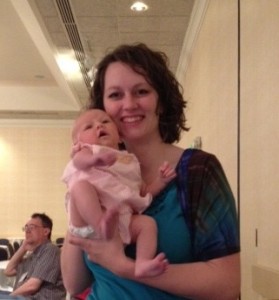Writing is a very lonely thing—we exist in our own world most of the time. It’s very different when we decide to put that world out there. We need a connection and a response.
Different writing communities serve different purposes.
Before you’re published you can ask others for feedback & technique training.
Once you’re published, you realize “Oh, that’s not the end.” It’s the beginning of a very different journey. You’re on a whole new plane now—now you have to be a public figure. In marketing—networking has been amazing—comparing notes, etc. And then you have your next project.
So, where do we start?
- At home! Often the hardest place to get the support that we want in our writing.
- It’s a risk—reaching out to people for support. But it’s a vital support.
- Make sure you’re giving the same support that you want to receive—you give as good as you get.
- Don’t expect more than is reasonable—have other people to help support you.
- Books—the Salt Lake public library was my friend! When I first started writing, I had so much to learn, and some amazing books on writing really helped me.
- Others—again, a risk—not always a good fit. Can be frustrating and discouraging.
- Physical groups—crit groups, classes, conferences. (If you’re outside of Utah and you want LDS authors, go to the Stake. If you can’t find any, try any other (ie non LDS) group.)
- Online: email, blogs, social networks, etc. Rules:
- Play nice in the sand box! This is a small sandbox; it’s not as big as we think. We meet these people face-to-face later on and remember what we’ve said to them online. Remember people (potential writer friends, readers, etc.) can find all these comments. Even if they don’t remember, even if you make up, you will remember this when you meet them.
- Reciprocate! You go to a community to get something, yes, but if everyone’s there just to get, no one’s there to give.
“People ask you for criticism, but they only want praise.” —Somerset Maugham. When someone argues with a critique (or when you disagree with a comment): weigh it out. Give it a chance. Don’t follow the initial impulse to argue. We have to realize people want to help us!
Example: Shelley, Keats, Lord Byron, Coleridge were in a writing group together. Maybe it’s NOT a coincidence…
Questions
How do you stay positive with criticism and with critiques?
- Point out the positive—good dialogue, good chapter length, good use of dialogue tags, good setting, etc.
- Refer them to specific books or resources that will also help explain.
What are your favorite writing books?
Jack Bickham: The 38 Most Common Fiction Writing Mistakes, Scene & Structure
James N. Frey: How to Write a Damn Good Novel
Orson Scott Card: Characters & Viewpoint
What size writing group is best?
I prefer them small because when we meet, we can get through everyone’s stuff in 2-3 hours.
How do you learn to critique?
By doing. [side note: I’m thinking about doing a series on this—any ideas/questions?]
Overview of an appropriate session:
We get together, 20-30 minutes chatting, then do one chapter a piece (10-15 pages). The author reads through those pages aloud. And then we go around the circle and give feedback aloud. We’ve also exchanged manuscripts—then we can blurb each other.
You can also try having each other read it (because they don’t do the inflection, you can see where people trip up on your writing).
You can also time responses if people tend to go on too long.
About the conference: LDStorymakers is a writing contest geared to LDS writers. The conference covers both the niche, regional publishers that cater to the LDS market as well as national publishers.
 Last week, I gave a class at the LDStorymakers Conference on gesture crutches. You can find my presentation here, but today I’m sharing the resources I cited in class!
Last week, I gave a class at the LDStorymakers Conference on gesture crutches. You can find my presentation here, but today I’m sharing the resources I cited in class!


